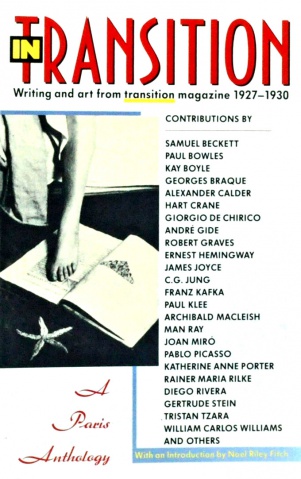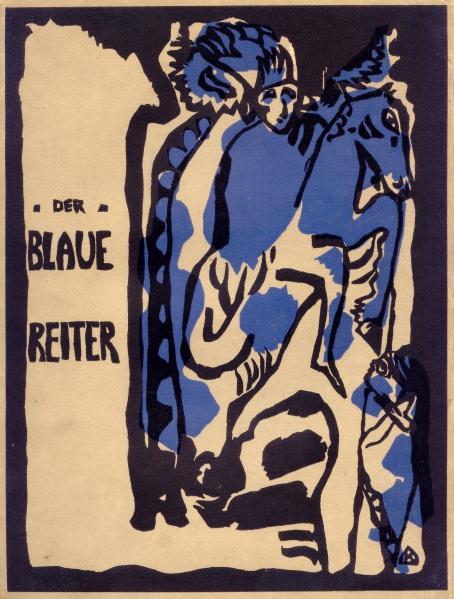In Transition: A Paris Anthology: Writing and Art from Transition Magazine 1927-30 (1990)
Filed under book, magazine, poetry | Tags: · art, avant-garde, dada, expressionism, literary theory, literature, poetry, surrealism

A selection of the some of the best writing to appear in transition, an experimental literary journal that featured surrealist, expressionist, and Dada art and artists. Founded in 1927 by Paris-based poet Eugene Jolas, it was originally intended to serve as an outlet for experimental poetry, but gradually expanded to incorporate contributions from sculptors, photographers, writers, civil rights activists, critics, and cartoonists. The magazine ran through the spring of 1938, with a total of 27 issues published.
With texts by Samuel Beckett, Paul Bowles, Kay Boyle, Georges Braque, Alexander Calder, Hart Crane, Giorgio De Chirico, Andre Gide, Robert Graves, Ernest Hemingway, James Joyce, C. G. Jung, Franz Kafka, Paul Klee, Archibald MacLeish, Man Ray, Joan Miro, Pablo Picasso, Katherine Anne Porter, Rainer Maria Rilke, Diego Rivera, Gertrude Stein, Tristan Tzara, William Carlos Williams and others.
With an Introduction by Noel Riley Fitch
Publisher Anchor Books, Doubleday, New York, 1990
ISBN 0385411502, 9780385411509
256 pages
via leninbert
PDF
Scans of 18 issues of the magazine (at National Library of France)
Gennifer Weisenfeld: Mavo: Japanese Artists and the Avant-Garde, 1905-1931 (2002)
Filed under book | Tags: · 1910s, 1920s, anarchism, architecture, art history, avant-garde, collage, communism, constructivism, dada, expressionism, futurism, graphic design, japan, marxism, socialism, theatre

“The radical Japanese art group Mavo roared into new arenas and new art forms during the 1920s, with work ranging from performance art to painting, book illustration, and architectural projects. Hurling rocks through glass roofs and displaying their rejected works, Mavo artists held peripatetic protest exhibitions against the Japanese art establishment. Ultimately, Mavo’s work became a major influence in Japanese commercial art and had a pronounced and lasting impact on Japanese visual and political culture. This abundantly illustrated volume, the first book-length study in English on Mavo, provides a critical evaluation of this often outrageous and iconoclastic movement, tracing Mavo’s relationship to broader developments in modernism worldwide.
Gennifer Weisenfeld provides a fascinating look into Japanese popular culture by showing how Mavo artists sought to transform Japanese art in response to the rise of industrialism. They deliberately created images that conveyed the feelings of crisis, peril, and uncertainty that were beginning to characterize daily life. Their art often alluded to mechanical environments through the use of abstracted imagery such as interconnected tubular forms and shapes reminiscent of riveted steel-plate girders. Looking in depth at the art itself, the flamboyant personalities of the artists, and the cultural and political history of Japan in this interwar period, Weisenfeld traces the strategies used by these artists as they sought to reintegrate art into daily experience.
Weisenfeld thoroughly documents the links between Mavo artists and a wide range of other artistic and political movements with which they associated themselves, such as futurism, dada, expressionism, socialism, and communism. Capturing the restlessness and iconoclastic fervor of Mavo, Weisenfeld is the first to fully locate this modern Japanese artistic community within the broader historical and intellectual framework of international art of the early twentieth century.”
Publisher University of California Press, 2002
ISBN 0520223381, 9780520223387
368 pages
Reviews: Patricia Failing (caa.reviews), Alexandra Munroe (J Japanese Studies), J. Keith Vincent (J Asian Studies).
PDF (95 MB, no OCR, updated on 2017-7-17)
multiple formats (Internet Archive, added on 2017-7-17)
See also Weisenfeld’s essay Mavo’s Conscious Constructivism: Art, Individualism, and Daily Life in Interwar Japan (1996, 10 pp) and
Hagiwara Kyōjirō’s Death Sentence (1925).
Kandinsky, Franz Marc (eds.): Der Blaue Reiter (1912–) [DE, RU, EN]
Filed under book | Tags: · art, art theory, avant-garde, cubism, expressionism, music, music theory

Der Blaue Reiter [The Blue Rider] was initiated in 1911 by the young painters Wassily Kandinsky and Franz Marc and was active until 1914. Conceived in June 1911 and published in Munich in May 1912, Der Blaue Reiter (Almanach) [The Blue Rider Almanac] presented their synthesis of international culture to the European avant-garde at large.
The Almanac was published in an edition of 1100 copies. Its costs were underwritten by the industrialist and art collector Bernhard Koehler, a relative of August Macke. It contained reproductions of more than 140 artworks, and 14 major articles. A second volume was planned, but the start of World War I prevented it. Instead, a second edition of the original was printed in 1914.
The contents of the Almanac included:
* Marc’s essay “Spiritual Treasures,” illustrated with children’s drawings, German woodcuts, Chinese paintings, and Pablo Picasso’s Woman with Mandolin at the Piano
* an article by French critic Roger Allard on Cubism
* Arnold Schönberg’s article “The Relationship to the Text”, and a facsimile of his song “Herzgewächse”
* facsimiles of song settings by Alban Berg and Anton Webern
* Thomas de Hartmann’s essay “Anarchy in Music”
* an article about Alexander Scriabin’s Prometheus: The Poem of Fire
* an article by Erwin von Busse on Robert Delaunay, illustrated with a print of his The Window on the City
* Macke’s essay “Masks”
* Nikolai Kulbin’s essay “Free Music”
* Kandinsky’s essay “On the Question of Form”
* Kandinsky’s “On Stage Composition”
* Kandinsky’s The Yellow Sound.
The art reproduced in the Almanac marked a dramatic turn away from a Eurocentric and conventional orientation. The selection was dominated by primitive, folk, and children’s art, with pieces from the South Pacific and Africa, Japanese drawings, medieval German woodcuts and sculpture, Egyptian puppets, Russian folk art, and Bavarian religious art painted on glass. The five works by Van Gogh, Cézanne, and Gauguin were outnumbered by seven from Henri Rousseau and thirteen from child artists. (from Wikipedia)
Second Edition
With two Forewords by Kandinsky and Franz Marc
Publisher Piper, Munich, 1914
140 pages
via Archive.org
Wikipedia (German)
Der Blaue Reiter (German, 1914, PDF converted from Archive.org’s JP2 scans, w/o blank pages, 43 MB, no OCR, multiple formats)
Siniy vsadnik (Russian, trans. Z.S. Pyshnovskaya, 1996, added on 2018-7-15)
English translation of the Forewords
Listen to Arnold Schönberg’s Herzgewächse (Audio)
Comment (0)
